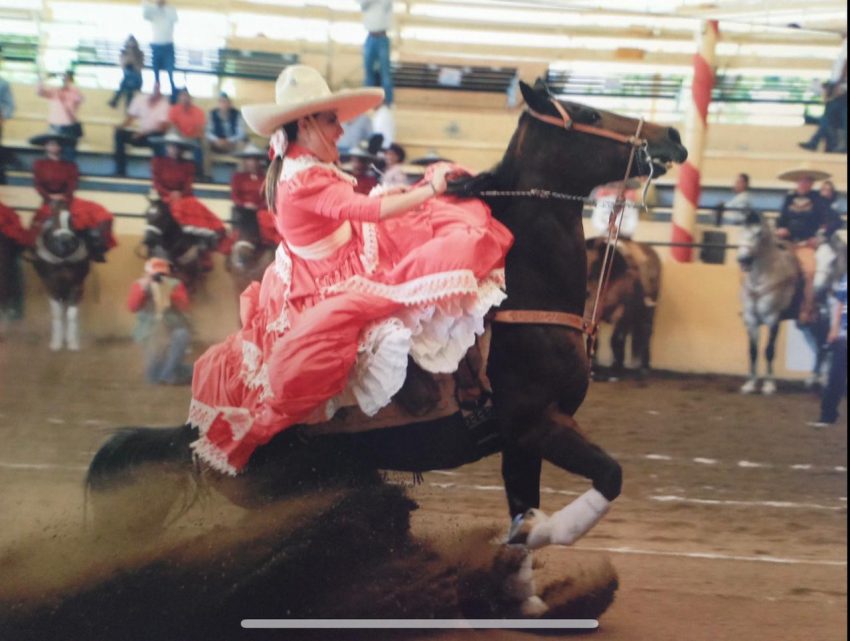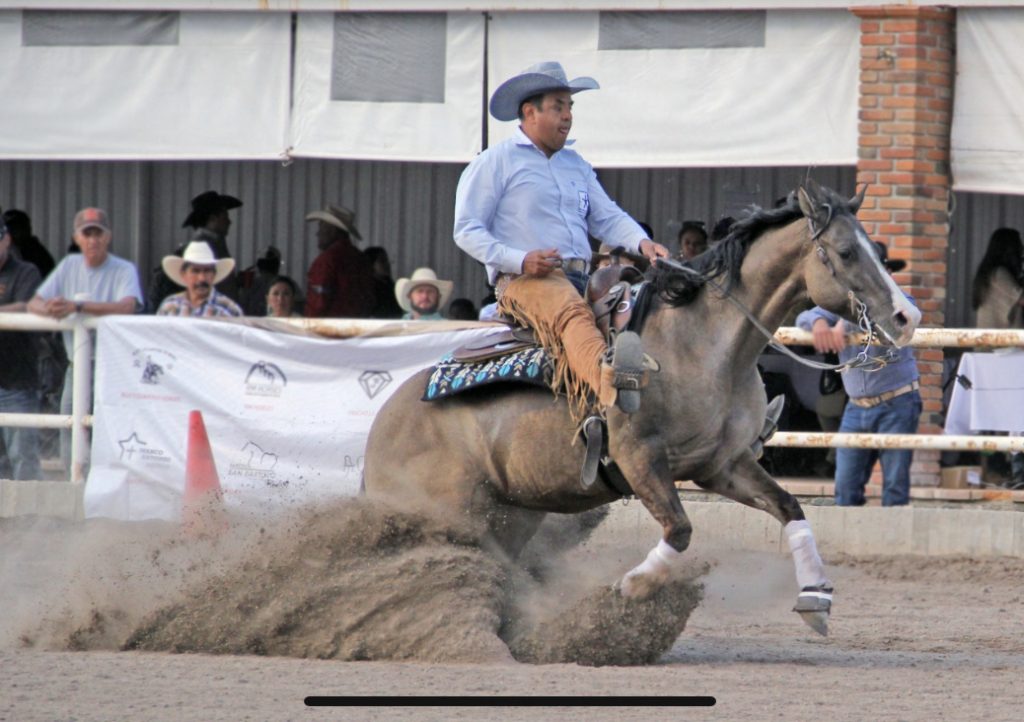
Still in its infancy, reining made its first real appearance in Mexico about 18 years ago when five professionals of Mexico’s national sport, Charreria, began looking for a better way of doing things: José Luis Briseno, Eduardo Briseno, Mariano Pedrero, José Luis Garcia, and Ruben Pacheco. Charreria is similar to reining in that it involves, stops, spins, rollbacks, and backups, but the execution of the maneuvers is much different. For Pacheco, reining was an avenue to improve his Charreria horses’ abilities in the beginning.
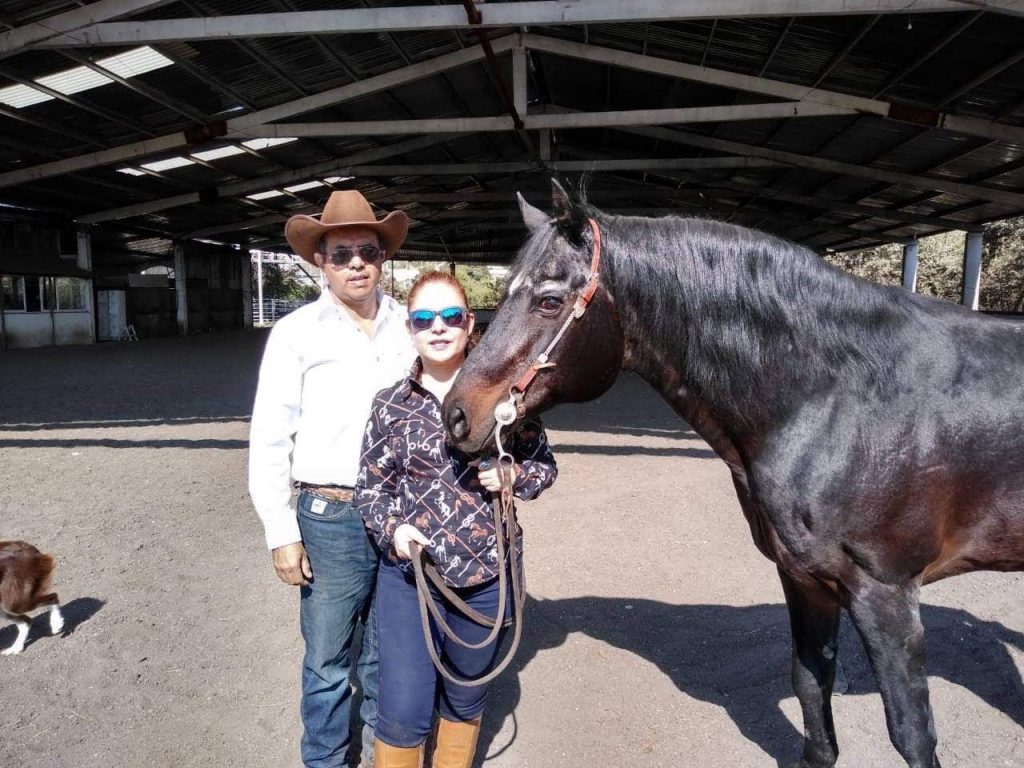
“I figured reining and Charreria would be very similar in the way we do things. I thought that I could get the videos of Tim McQuay and see what they are doing and make my Charreria horses better,” he said with a chuckle. “In the videos, I saw the benefits and the projection that the sport of reining had worldwide, and I decided to pursue it.”
Pacheco began to seek out people he knew who were already involved in reining, such as NRHA Judge and bit maker, Greg Darnall, professional trainer José Montalvo, and NRHA Judge Ann Salmon-Anderman for more information. He learned that there were many benefits to reining, including more events to enjoy, international competitions with the horses, and better training techniques which reiners readily shared, a trait not common in Charreria.
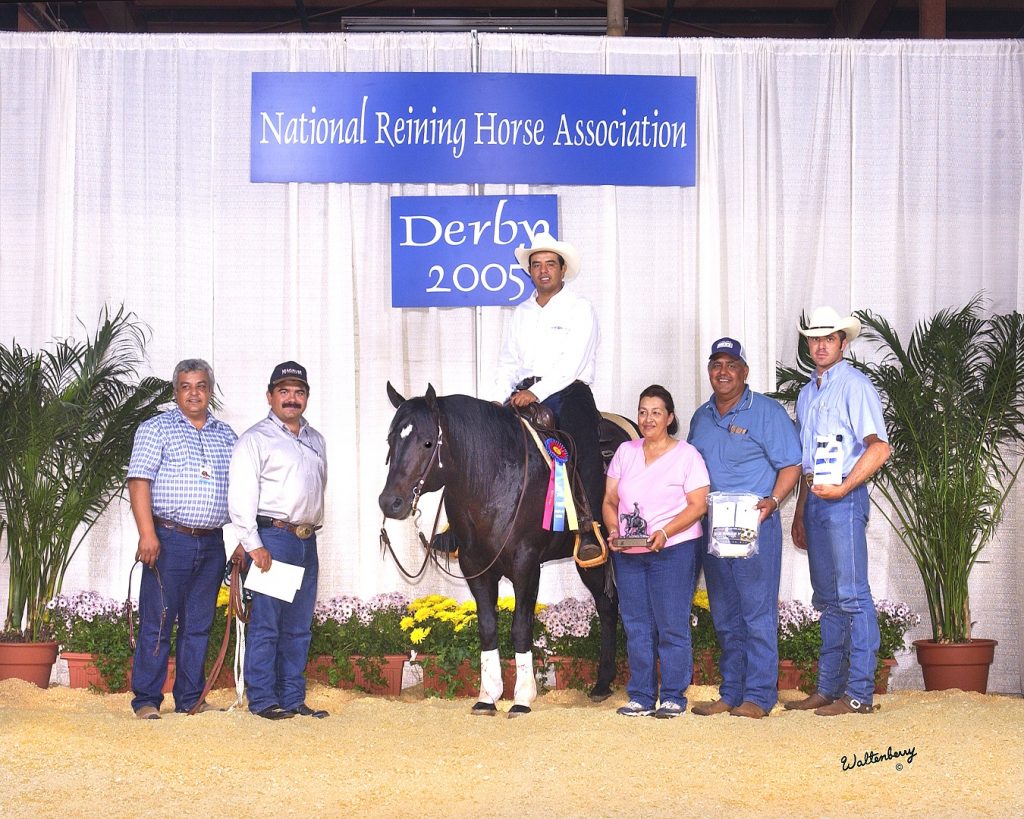
“I have been fortunate to be in Europe competing and getting good returns there and in the U.S.A. You can meet people from all around the world involved in reining and who love horses. The other thing I saw in reining is that it is an industry; you can invest here and get good experience and good money back if you do it correctly. The money you invest here can be safe. That is one of the great things about this sport,” he said.
Pacheco and some of the men felt like it was best for the furtherance of the sport to become affiliated with the National Reining Horse Association, while others knew it would make reining more expensive for all of them. Finally, it was decided that for the betterment of the industry, Mexico needed to become an NRHA Affiliate, and they set out to make it happen.
The group put on shows in various parts of Mexico and then created a National Reining Championship to further promote the sport; however, they were still missing something. “There were more gentlemen than ladies in the beginning. We were just focused on promoting reining, but nobody did anything to get more women involved. There were a lot of gentlemen practicing and learning the new way of riding, but the ladies really didn’t have much chance of winning in the beginning,” Pacheco explained.
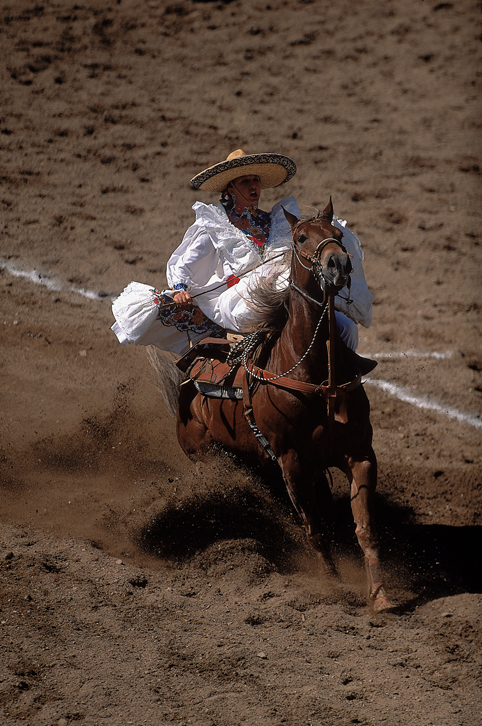
The culture in Mexico is rather patriarchal. Mexican men are expected to be masculine, self-reliant, and dominantly protective of women. They are expected to provide for the family unit no matter the cost, while women are expected to subserviently give of themselves, often at the cost of their own self-interests, mainly as homemakers. Many women didn’t have time to practice new horsemanship skills, and their culture suggested to some of them that it was wrong to pursue their own hobbies. There were still horsewomen in Mexico, but most were barrel racers or partook in the female version of Charreria, called Escaramuza.
Escaramuza is an important element of the role of Mexican woman. Having begun in 1953, when women began to take part in the all-men’s Charreria competitions. This event, steeped proudly in Mexican history, defies the cultural traditions of gender roles in Mexico and women still ride sidesaddle as part of an all-female team, all wearing the dazzling, traditional dresses and large sombreros of the time period it first began. The opening of each team’s run features the women running into the arena in formation at full speed. Just like in reining, there are large championships with attractive payouts.
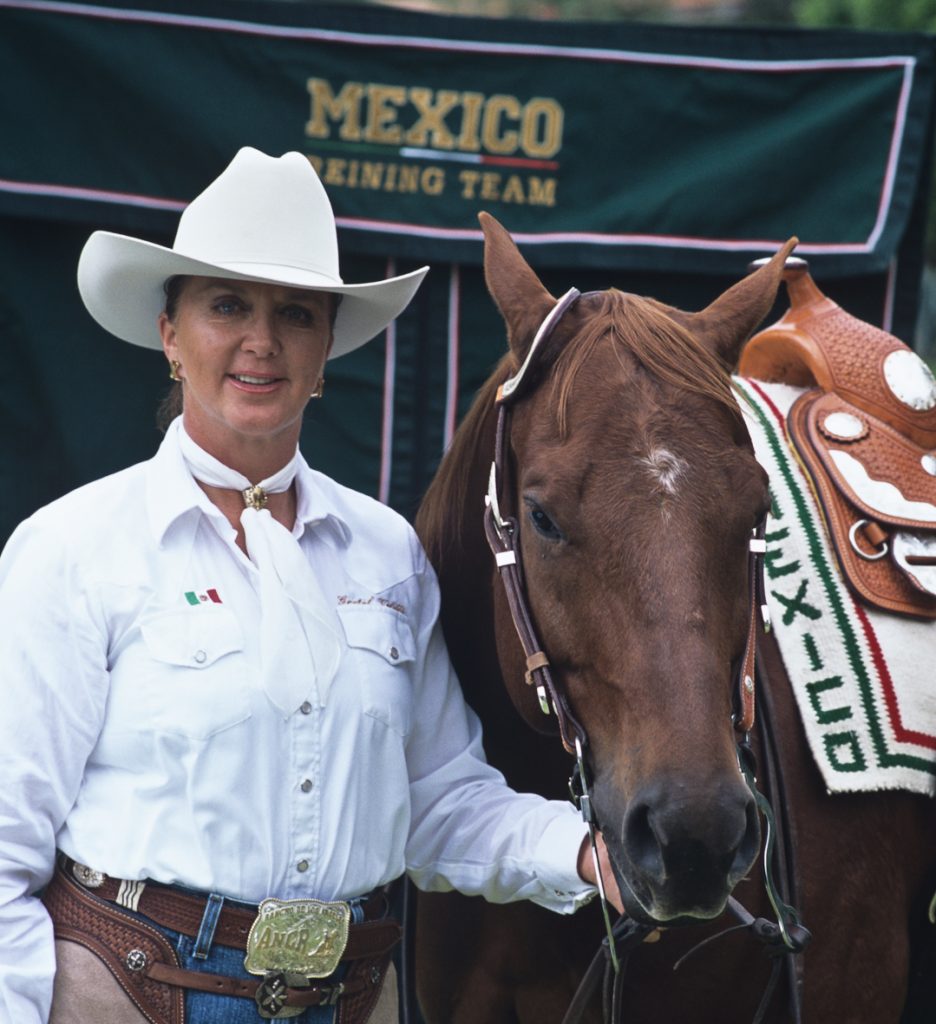
There was, however, one woman carving a way for other females in the sport. Her name was Gretel Valdes. She already had quite a reputation in Escaramuza, having been invited to the 1993 Europalia Arts Festival with her team to demonstrate their craft in Belgium. She recalled, “Javier Alvarez Malo brought reining to Mexico. He was a very good rider, charro-style. He invited me to ride with him and he showed me what the reining was about. That’s how I met Greg Darnall. They showed me what reining is, and I said, ‘That’s what I want to do!’ because I can do it alone. I can do it all day or not. At that time, I was 45 years old, and I had been side saddle all of my life. It was not an easy transition for me!”
Malo organized the first reining competition in Mexico in 2000 with Darnall as the judge; however, all of the competitors had transitioned from Charreria, so they used charro saddles and outfits. Valdes wore a full-skirted dress, and men dressed in ornately embroidered outfits, all were topped with large sombreros. Valdes tied to win that show and refused a coin flip. She wanted to run it off which tipped the scale in her own favor. She, the only woman competing, won the class.
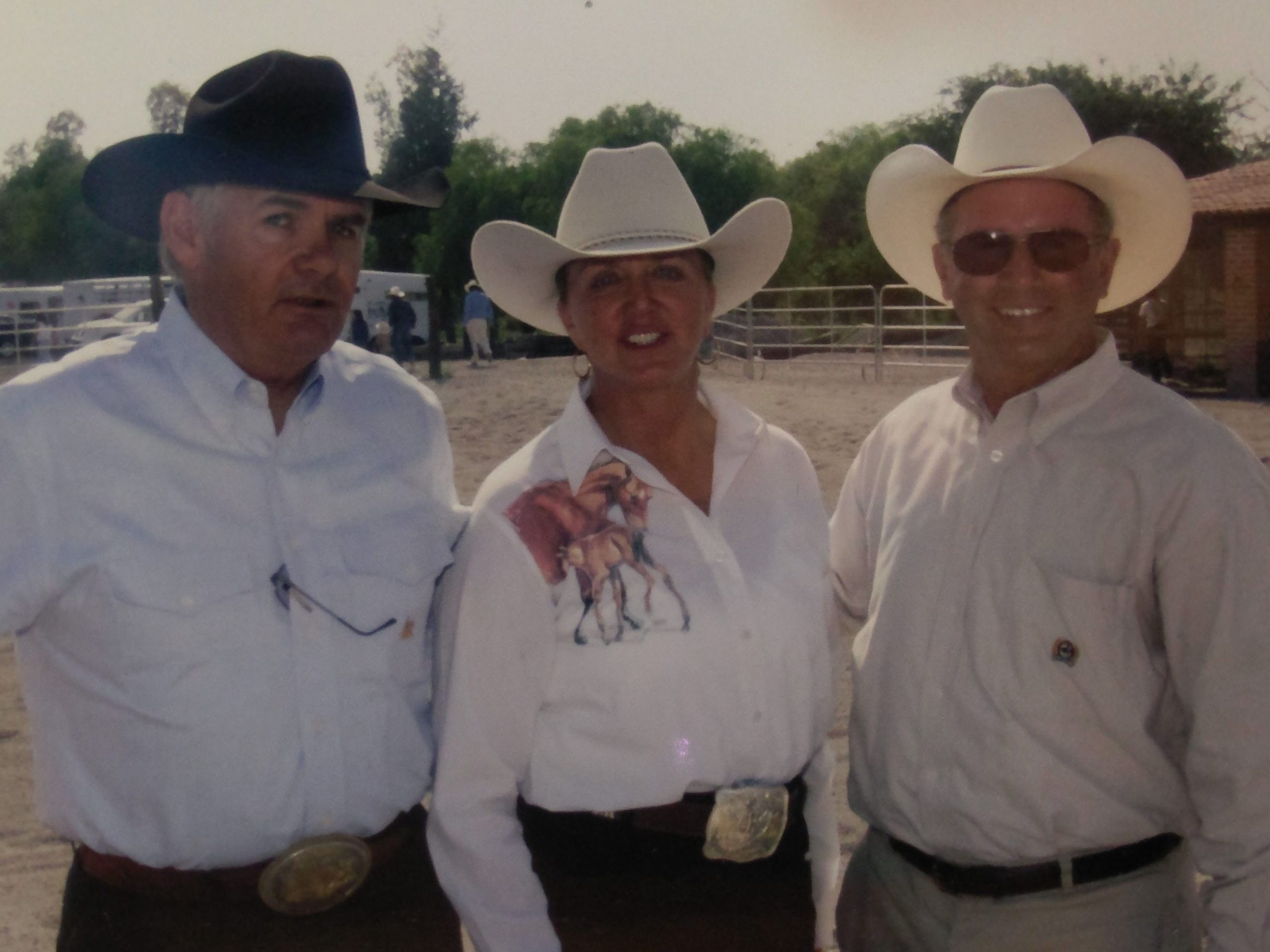
“I was always the only woman, everywhere! The males in Mexico are very macho, and they didn’t want to let me go in. I learned very quickly how to survive with all those guys and having blond hair and blue eyes…I had to fight very hard to survive. I had to be smart,” Valdes, whose father was German, shared.
“It was very, very hard in that time, because men were the only ones competing, and they didn’t want women to be competing against them. If you, as a woman, won, they would be very mad,” she continued. “But in my life, I have had angels with me: amazing angels. The president of the Asociación Mexicana de criadores de caballos Cuarto de Milla (Mexican Quarter Horse Breeders Association), Salvador Jimenez Cano, was helping me. He had a wife and a daughter that showed, so he was happy that I was making a way for women in Mexico. The owner of the place where I was working at the time said, ‘We need a competition just for all the girls? Let’s do it!’ Greg Darnall is also my angel in Mexico.”
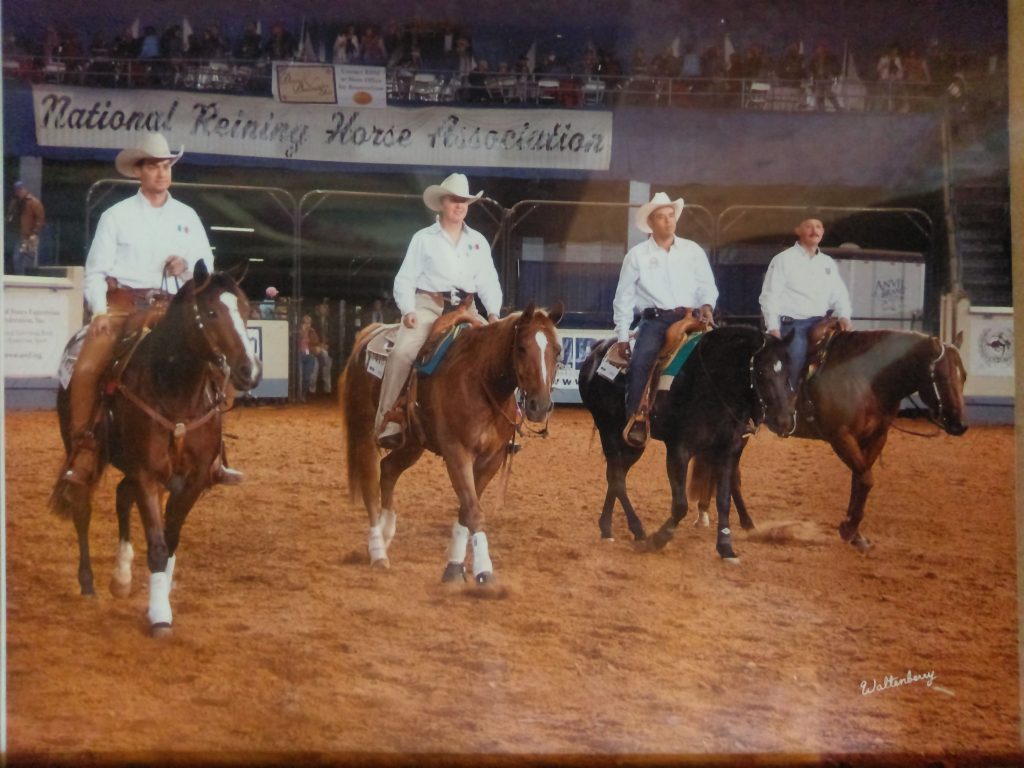
After her success at that first show, Valdes stopped competing in Escaramuza, but remained in high demand to coach teams of girls in the event. Her program was never the same again, though, because she constantly tried to teach her students the methods she learned in reining.
After attending a couple more shows in Mexico, Valdes met Yvonne Mathieu, a Canadian reining trainer who was living in California. She asked him for reining lessons, and he agreed, but she would have to come to him in California.
She arranged a flight to California and began her lessons using horses in Mathieu’s barn. “I wasn’t sure who had it worse: them or me!” she said with a laugh. He would say, ‘Why do you do that? Why are you doing that with your hands? Why do you hold the horse? Release your legs!’ I said, ‘I can’t!’ Some days I would just cry so hard!”
Valdes never let her frustration dampen her dream. While training with Mathieu, she heard about the World Equestrian Games, hosted in Aachen, Germany, coming up, and set her sights upon it. She was told that she would have to go to two or three international competitions to earn points for qualification, but because she rarely had her own horse available, she often showed in the open. “I borrowed a horse there in California, and Yvonne said, ‘I’ll take you to Oklahoma, but the competition is in two days, and it takes two days to get there.’ We drove 26 hours nonstop to make it there. It was my first time in Oklahoma. It was so cold; I was shaking like crazy!” she remembered.
After that cold show in Oklahoma’s December weather, Valdes traveled to Katy, Texas for her second international qualifier where she met NRHA $2 Million Rider Casey Deary. The two hit it off immediately, and she moved her training to Deary Performance Horses, often cleaning stalls, riding horses, and cooking Mexican food for the Dearys, whether at their ranch in Weatherford, Texas or at her home in Mexico.
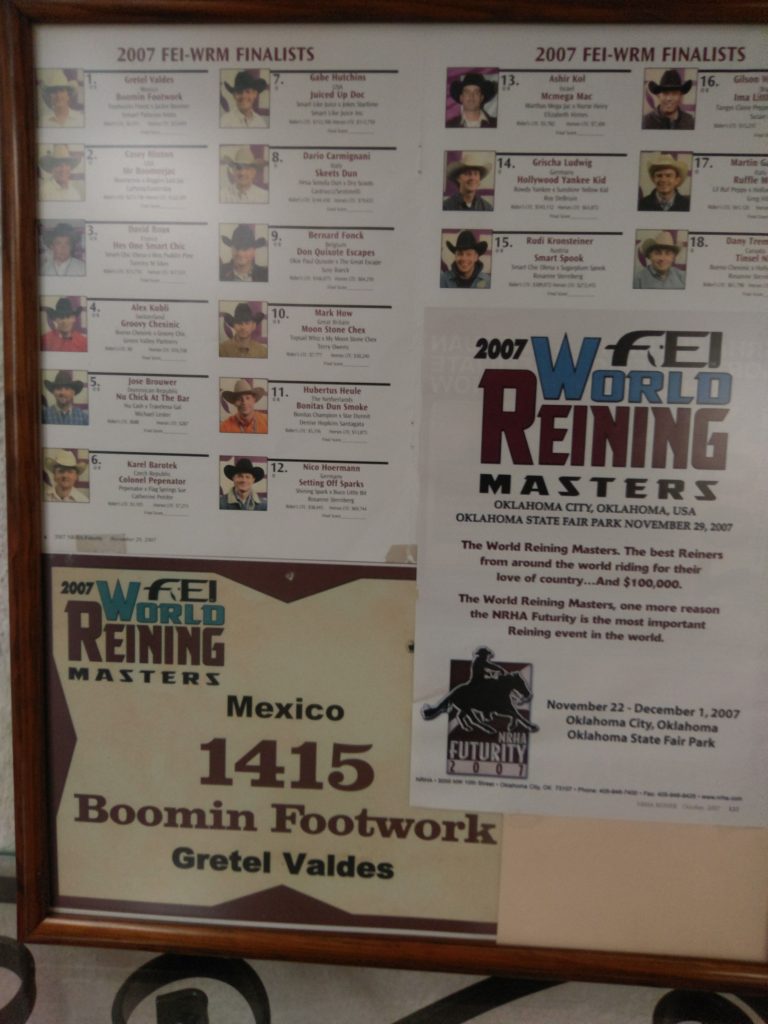
Through sheer grit and determination, Valdes met the qualification requirements for the 2006 WEG, helping to create an international qualifier in Mexico in the process, and paving a path for reiners in all of Mexico to follow. “The owner of the horse I took paid for its transport, and I covered my own expenses, but besides my husband, I went alone,” she lamented. “I had no trainer; no chef d’quipe. The Mexican Federation was a little bit supportive of me. They came to watch my show but didn’t give me any money at all. Not one peso!
“It was a great experience, though, to take the horse by plane and go from Mexico City to Amsterdam, then to Belgium. I was competing with all the top guys from all over the world. I was by myself, but I don’t think I did so bad. I got a 70 from all of the judges.”
Over the next eight years, Valdes helped to organize many more international competitions in Mexico and served as chef d’quipe for the Mexican team that went to Lexington, Kentucky in 2010 and to Normandy, France in 2014.
“I have always had big angels in my life, and I am very grateful that I was able to make a path for other women in reining competition. Some people are born and die, and don’t leave anything behind. I have made a path for all the girls in the charro style. I was a beginner in making the regulations for girls in that. Right now, we are making a group for the girls who ride in the charro style. When you really make something in your life, you leave a path for other girls to follow so they can grow and compete and do things too. When you have things too easy, you don’t appreciate it. For me, it is important that the girls have things equal, like the guys, like in reining: Equal,” Valdes shared.
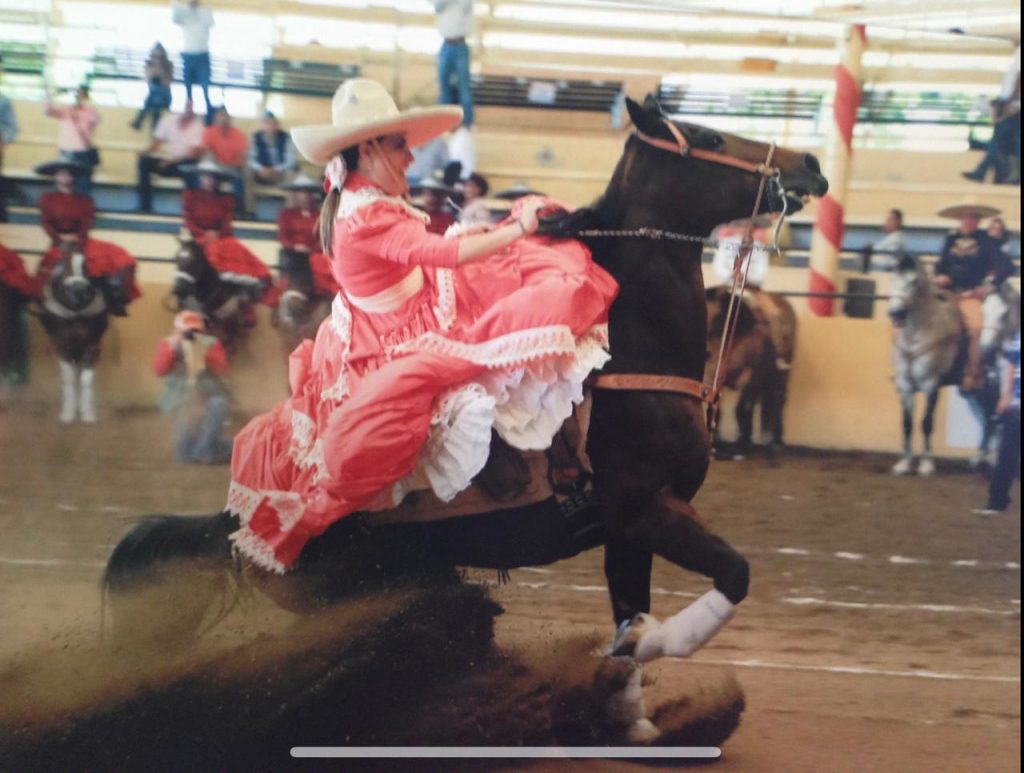
One such young woman that followed the path carved by Gretel Valdes was Eunice Ruiz-Bravo. She too transitioned from escaramuza, which she started when she was 12, in search of an event that she could do individually. She tried ranch sorting and barrel racing, but it was the challenge of reining that held her heart.
Ruiz-Bravo said, “When I trained in Charreria, my horses were taught to stop with reining techniques so I would practice my stops at Apapataro with my trainer, Javier Alvarez Malo. After a few years, the place in Queretaro where we practiced Escaramuza was demolished, so I continued at Apapataro where Javier began teaching me reining. He had to have a lot of patience with me because I had always ridden sidesaddle and didn’t know how to use my legs.”
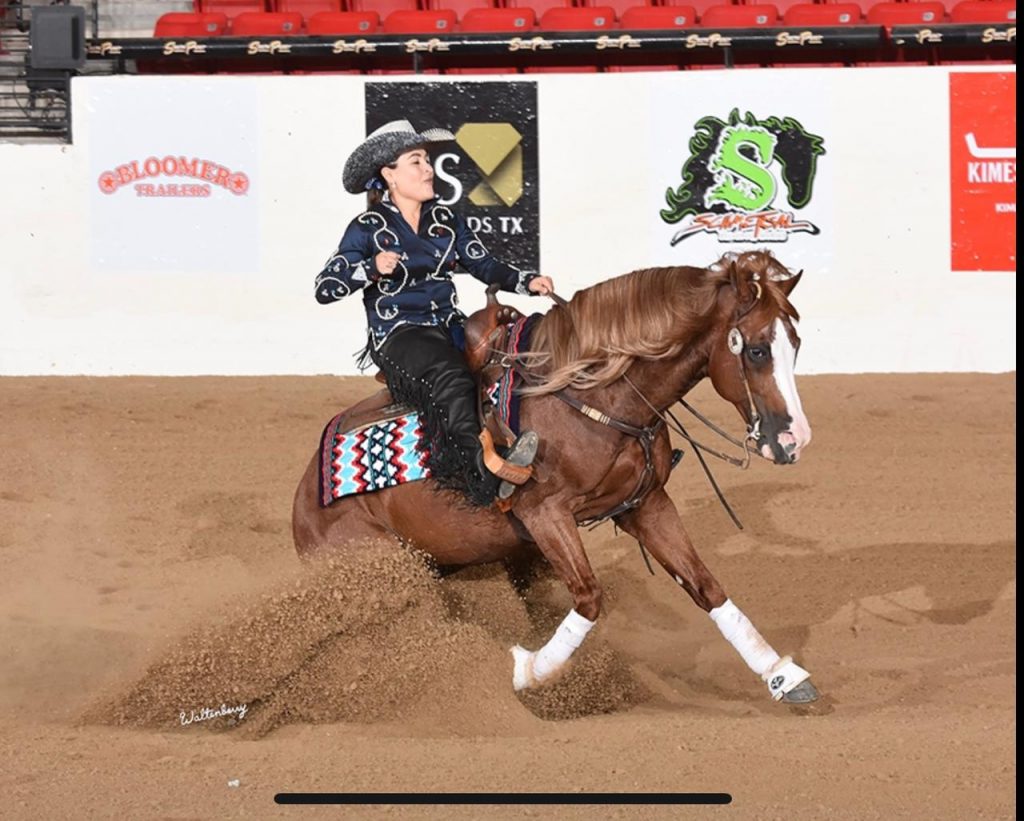
In the beginning, she showed with men in Green Reiner and Rookie classes, and there were only four women among all of the men, but since Pacheco helped create the women-only category, it has become a tradition in Mexico. Now it is common for 20 or more horses to be entered, and there are more and more women moving up the ranks into the Non Pro.
“At the time I started competing, in 2017, Atlixco Puebla was the first reining show where there was a category called ‘Señoritas’ created only for women. I remember in 2018, José Vazquez sponsored a beautiful trophy for the ladies in the Affiliate finals in Mexico. We all wanted to take it home! It was a very exciting show for me because Rocio Ruiz and I tied and decided to run it off. Everyone was surprised because it is common for men to decide to be co-champions. That was my first NRHA trophy!”
Ruiz-Bravo went on to earn many titles in reining competition including 2019 Gold N Grand Green Reiner Champion, 2021 Guadalajara Reining Classic Rookie Reserve Champion, and 2021 Reining By The Bay Green Reiner Level 2 Reserve Champion. One of the laurels she’s most proud of is becoming the first Mexican national to qualify for The Run For A Million Rookie Challenge in Las Vegas in 2021.
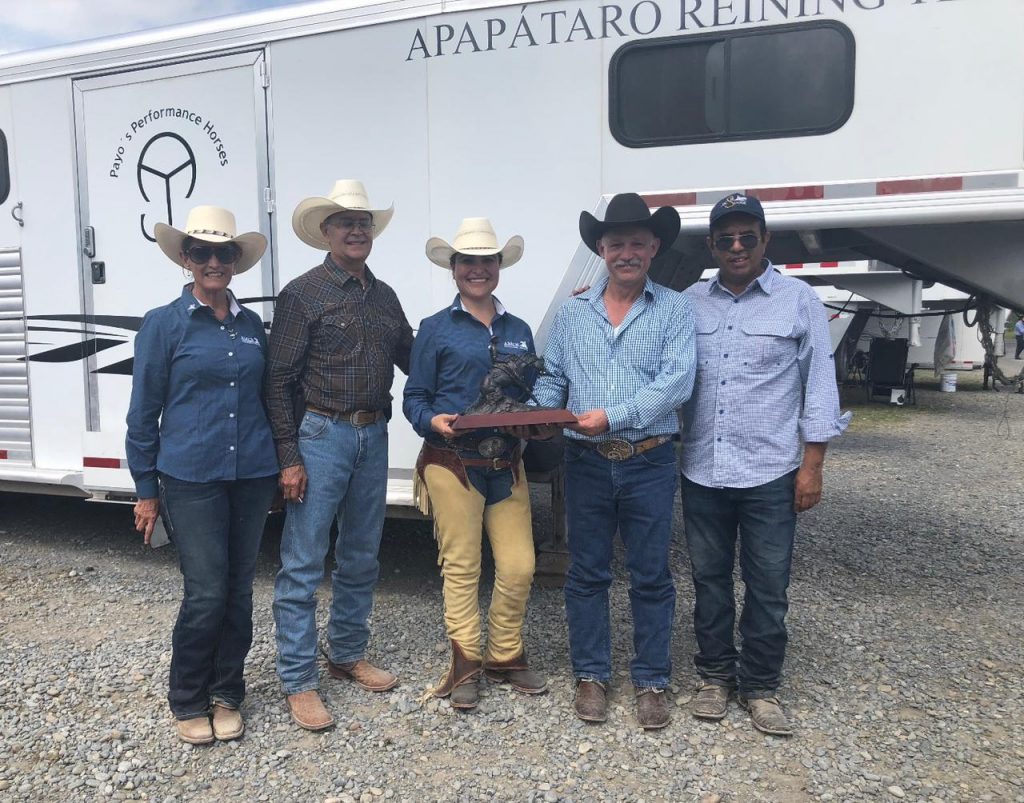
Ruiz-Bravo manages the administration of her father’s construction company which allows her to work remotely as she travels often to California to train with Martin Padilla. Filled with a desire to share how wonderful the shows are in America with her Mexican brethren, Ruiz-Bravo supported her family in the erection of an Equestrian Center in Queretaro, Mexico called “Tofico” after her favorite Escaramuza horse. She believes that the key to increasing participation from women and youth in Mexico is in “doing the activity in a friendly and familiar environment, in a place where you feel safe and like to spend time with your horse and friends in the middle of nature, but still close to the city.”
She said, “It is my dream that more women and children would ride horses and especially reining horses because I am convinced that riding horses educated us with discipline and fills us with emotional strength and leadership making us positive people for the society we live in.
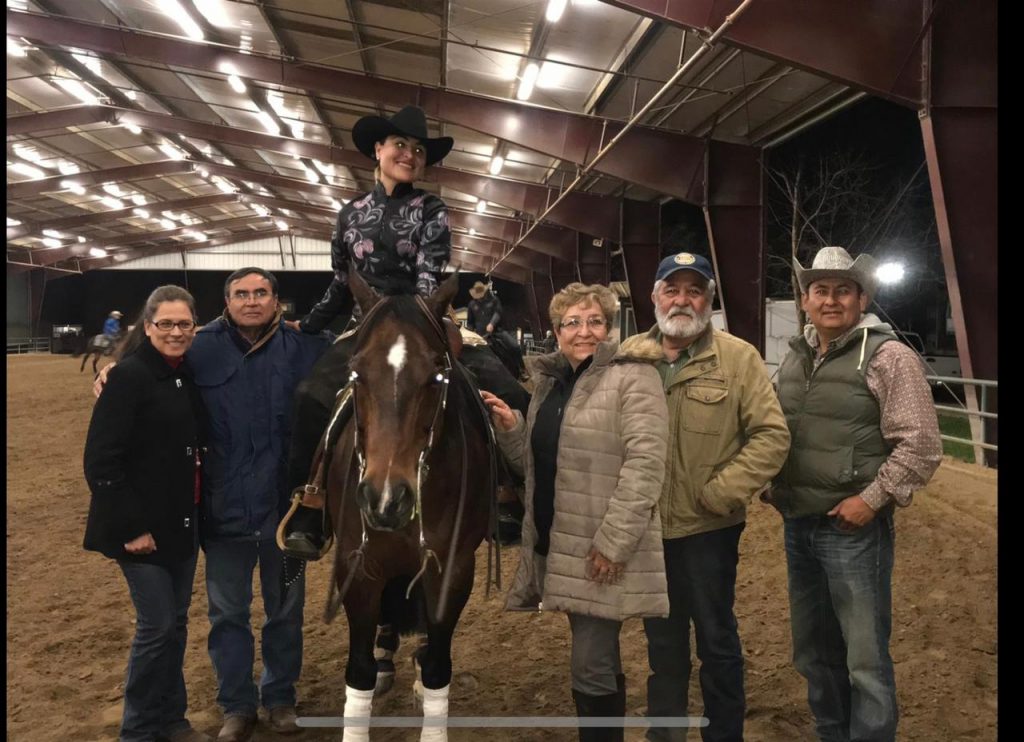
“I am very blessed by the family I have. My parents, Maximiano and Lupita Ruiz-Bravo, have always supported me and my brother to achieve our goals without excuses or limits and having my uncle and aunt Toño and Angelica Bravo in California makes me feel like I have parents in California too. I thank God daily for the wonderful family of which they are a part. I am especially grateful for my brother, Maximiliano. He is without a doubt my closest companion and teacher throughout my life. He is always available to me when I need him.”
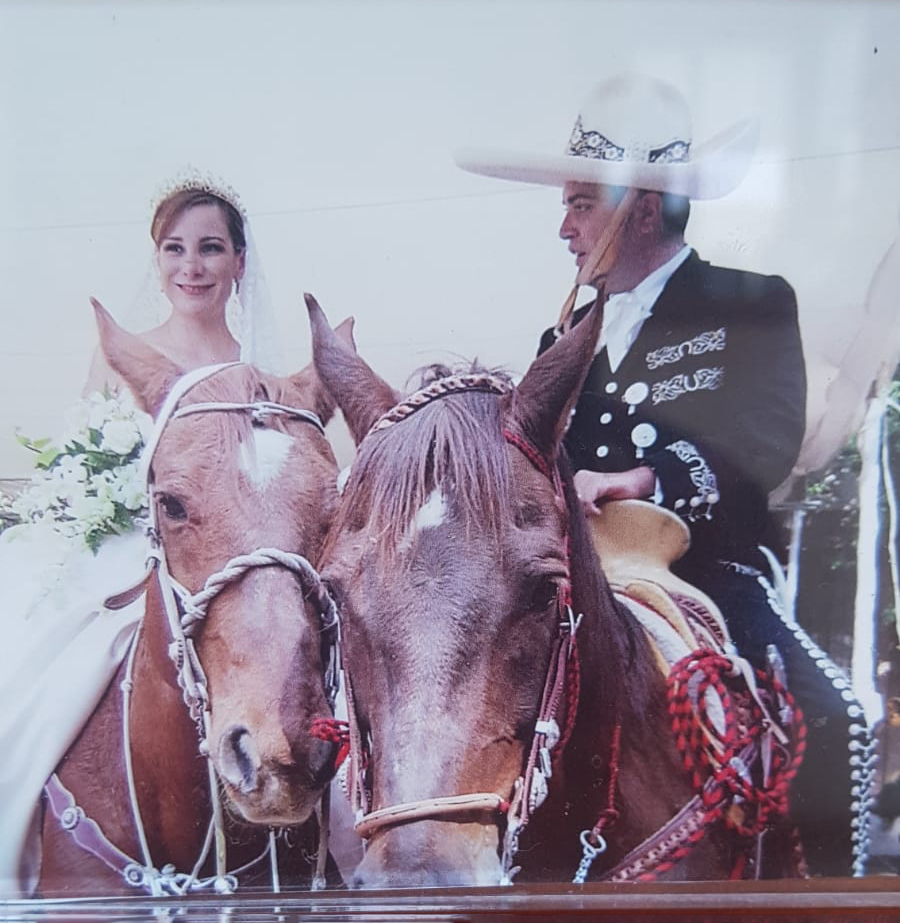
Another daughter of Mexico who was drawn to reining is Karla Ruiz-Soto, but unlike Pacheco, Valdes, and Ruiz-Bravo, she didn’t start out in Charreria. “I have always loved animals, but I was never interested in horses until I married José Soto in 2004. He used to be a charro, but as he got older, he stopped doing Charreria and was only interested in horses. He bought a horse just for riding, and I started riding just for fun. When we started looking for a job to do with the horses, we ended up at a ranch where reining was practiced,” Ruiz-Soto said. “We bought two reining mares and wanted the trainer to compete on them, but he wasn’t very interested in showing them, so I decided to learn how to do it.
“At first, I was terrified! It was a nightmare for me. I was really scared of horses. I just froze when I was on a horse. When I saw others could ride them so well, and I couldn’t, I realized that something was not right, so I decided to prove myself!”
After Ruiz-Soto met trainer Juan Beltrán, the tides began to turn for her. “Juan trained our two mares very easy in order for me to ride them. I really committed to success and trained very hard. I put my fears aside, and one day, I could do the impossible! It was teamwork: my husband, my trainer, and me. Today, reining makes me feel so alive. It still scares me, but nothing compares to when you accomplish your goals,” she said.
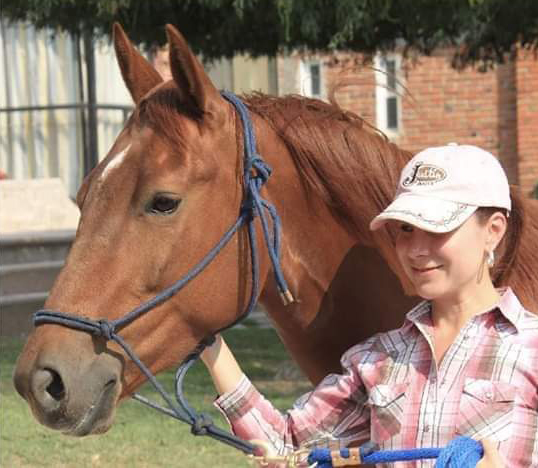
One of her most memorable accomplishments was qualifying for the North American Affiliate Championships and winning Rookie of the Year in Mexico in 2019.
During the COVID-19 pandemic in 2020, the Sotos were not able to pursue one of their favorite pastimes, traveling, so they poured their time into the other, horses. In March 2021, they began construction on Rancho San José in Pedro Escobedo, Querétaro. The facility currently features a covered arena, an outdoor arena, and 40 stalls. Its inauguration event, “San José Reining Cup,” is slated for May 20-22 and will feature an affiliate competition and a derby.
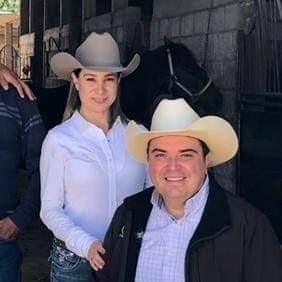
Mexico kept reining alive during the pandemic of 2020 by incorporating an online show called “Quedate en Casa” or Stay at Home. As people submitted video performances from their own ranches. The show featured the all-ladies, Señoritas class making it a big push for many women to participate. Ruiz-Soto, in fact, won a circuit buckle during this show.
While she has seen the success that the Senorita’s class has had in bringing more women into reining, Ruiz-Soto feels that there is still room for improvement in the industry as a whole. She said, “I think the Senorita’s class needs to be divided into categories determined by a person’s earnings and whether they are Rookie, Green or Non Pro. I also think that if we offer clinics with discounts to women, it will help. Most of my friends think that riding a horse is dangerous.”
Another reason that women do not participate or continue to participate in reining once they have started is because of the commitment required to be successful. Many women are already busy with their families or studies, but for Ruiz-Soto, it is the challenge that keeps her hooked. “Reining has been the difference between a normal life and a very exciting one. It has been the fuel that moves the lives of my husband and me. We have known great people through it. Thanks to it, the feeling I have when I am in competition has no comparison. I feel so alive. I really hope this sport will succeed in Mexico,” she said.
“As the Señoritas classes caught on more and more, there were sometimes more ladies showing than we had riders in the Open draw!” Ruben Pacheco admitted. “The ladies seem to think that they have to do more and more to prove themselves. Not even the trainers could figure that the ladies could become, probably, better horsemen than the gentlemen! They are more serious about practicing. They are more caring to the horses and compromise more with them. The trainers are figuring out how valuable it is to have a lady on their team or as a customer. Every day, they are doing better and better with them.”
With such strong, talented, and determined women as Valdes, Ruiz-Bravo, and Ruiz-Soto leading women into the sport, and visionary men like Pacheco backing them, the future is bright for female reiners in Mexico. For more information about the Mexican Affiliate, click here.

